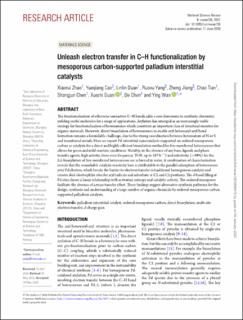| dc.contributor.author | Zhao, Xiaorui | |
| dc.contributor.author | Cao, Yueqiang | |
| dc.contributor.author | Duan, Linlin | |
| dc.contributor.author | Yang, Ruoou | |
| dc.contributor.author | Jiang, Zheng | |
| dc.contributor.author | Tian, Chao | |
| dc.contributor.author | Chen, Shangjun | |
| dc.contributor.author | Duan, Xuezhi | |
| dc.contributor.author | Chen, De | |
| dc.contributor.author | Wan, Ying | |
| dc.date.accessioned | 2023-02-22T11:33:37Z | |
| dc.date.available | 2023-02-22T11:33:37Z | |
| dc.date.created | 2021-12-09T09:30:39Z | |
| dc.date.issued | 2021 | |
| dc.identifier.citation | National Science Review. 2021, 8 (4), . | en_US |
| dc.identifier.issn | 2095-5138 | |
| dc.identifier.uri | https://hdl.handle.net/11250/3053201 | |
| dc.description.abstract | The functionalization of otherwise unreactive C–H bonds adds a new dimension to synthetic chemistry, yielding useful molecules for a range of applications. Arylation has emerged as an increasingly viable strategy for functionalization of heteroarenes which constitute an important class of structural moieties for organic materials. However, direct bisarylation of heteroarenes to enable aryl-heteroaryl-aryl bond formation remains a formidable challenge, due to the strong coordination between heteroatom of N or S and transitional metals. Here we report Pd interstitial nanocatalysts supported on ordered mesoporous carbon as catalysts for a direct and highly efficient bisarylation method for five-membered heteroarenes that allows for green and mild reaction conditions. Notably, in the absence of any base, ligands and phase transfer agents, high activity (turn-over frequency, TOF, up to 107 h−1) and selectivity (>99%) for the 2,5-bisarylation of five-membered heteroarenes are achieved in water. A combination of characterization reveals that the remarkable catalytic reactivity here is attributable to the parallel adsorption of heteroarene over Pd clusters, which breaks the barrier to electron transfer in traditional homogenous catalysis and creates dual electrophilic sites for aryl radicals and adsorbate at C2 and C5 positions. The d-band filling at Pd sites shows a linear relationship with activation entropy and catalytic activity. The ordered mesopores facilitate the absence of a mass transfer effect. These findings suggest alternative synthesis pathways for the design, synthesis and understanding of a large number of organic chemicals by ordered mesoporous carbon supported palladium catalysts. | en_US |
| dc.language.iso | eng | en_US |
| dc.publisher | Oxford University Press | en_US |
| dc.rights | Navngivelse 4.0 Internasjonal | * |
| dc.rights.uri | http://creativecommons.org/licenses/by/4.0/deed.no | * |
| dc.title | Unleash electron transfer in C-H functionalization by mesoporous carbon-supported palladium interstitial catalysts | en_US |
| dc.title.alternative | Unleash electron transfer in C-H functionalization by mesoporous carbon-supported palladium interstitial catalysts | en_US |
| dc.type | Peer reviewed | en_US |
| dc.type | Journal article | en_US |
| dc.description.version | publishedVersion | en_US |
| dc.source.pagenumber | 0 | en_US |
| dc.source.volume | 8 | en_US |
| dc.source.journal | National Science Review | en_US |
| dc.source.issue | 4 | en_US |
| dc.identifier.doi | 10.1093/nsr/nwaa126 | |
| dc.identifier.cristin | 1966506 | |
| cristin.ispublished | true | |
| cristin.fulltext | original | |
| cristin.qualitycode | 1 | |

